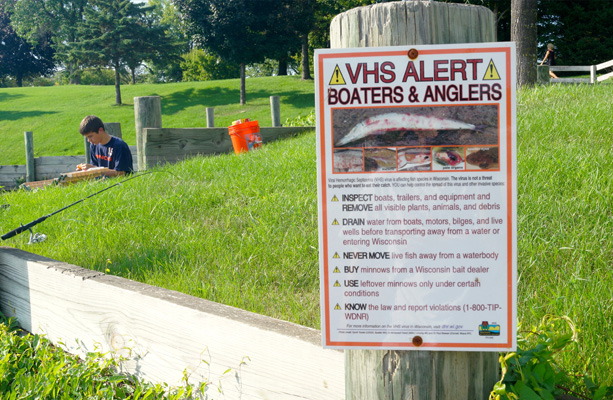Preventing New Invasions: Genetic Tools as an Early Warning System
Beyond Ballast Water: The Great Lakes’ Role in Early Applications of Environmental DNA Techniques
- By Bob Dolgan
Since the mid-1990s, the Great Lakes Protection Fund had been seeking ways to stop new invasions of non-native species. The Fund had made headway in developing ballast water treatment systems, but vessel operators and authorities had no way of knowing what was living in the ballast tanks of ships already present in the region’s water.
David Lodge, then biologist at the University of Notre Dame, thought he might have an answer to the problem. His idea was to use environmental DNA (eDNA), a new technique developed in France, to detect the genetic material of new, and potentially new, invaders. Lodge’s team addressed several species including the golden mussel, Chinese mitten crab, zebra mussel, and quagga mussel and applied this genetic approach to enable early warning and swift management response.

“We were excited, but we were pretty skeptical when we went to work,” said Lodge. The team’s approach to the technology evolved over the course of the project.
They successfully demonstrated an accurate, genetic-based, portable detection platform suitable for surveillance of ballast tanks.
But that’s not where the story ends.
Tracking Asian Carp Near Chicago
Lodge’s work began not long after authorities stepped up their response to the notorious Asian carp approaching the Great Lakes basin. The imported fish species had made their way up the Mississippi River system and were approaching Lake Michigan. The devastating impact of Asian carp on other water systems made it a cause célèbre for the Great Lakes and drew the interest of members of Congress and the Obama Administration.
The application of eDNA would make it easier and faster to know whether the fish might be in the waters near Chicago. Traditional detection methods were laborious, ranging from electrofishing (temporarily shocking fish) to using nets to sweep the bottom of the waterway. Speed and accuracy were a priority.

“The Protection Fund was very influential on my thinking as a scientist who wanted to do work that benefits society,” said Lodge, who now heads up the Atkinson Center for a Sustainable Future at Cornell University. “They pressed me to think in terms of a theory of change and a pathway to impact.”
With Fund support, Lodge and his team worked with the U.S. Army Corps of Engineers to apply eDNA methods to the Asian carp problem in Chicago waterways. Though scientists caution that the presence of genetic material—scales, cells, feces or mucus—doesn’t necessarily mean a live fish is present, it does indicate a fish has been present recently. This is helpful, but not necessarily actionable information.
Current Fund investments are sharpening the understanding of how quickly eDNA decays, so test results carry more meaning and lead to more decisive management actions.
Development on the Great Lakes Supports Global Impact
Lodge’s team trained Army Corps and U.S. Fish and Wildlife Service (USFWS) personnel to use the eDNA methods in Chicago. The USFWS has since expanded the eDNA applications throughout much of the United States.
According to Emy Monroe of the USFWS’s Whitney Genetics Lab, “[eDNA] has really taken off. It’s pretty cool.”
eDNA methods have since proliferated around the world and are being used to detect everything from the presence of killer whales in the Pacific Ocean to poorly understood species in the Amazon River basin. Pioneering work to protect the world’s largest freshwater system helped to make these new tools available.
Other Genetic Applications
While jumping Asian carp are a well-known threat, genetic tools are also being used to detect the tiniest of invaders—harmful microbes that can wreak havoc in the ecosystem.
A team led by Allegra Cangelosi, formerly of the Northeast-Midwest Institute, produced new genetic tools that were the first to detect the deadly VHS virus (viral hemorrhagic septicemia) in Lake Superior. VHS, an infectious fish disease that can cause a variety of fatal symptoms, has been the source of large fish die-offs. It had been detected in the lower Great Lakes for years.

The detection of VHS for the first time in Lake Superior by researchers at Cornell University led to swift action. The resulting emergency regulations and restrictions that were enacted across Lake Superior prevented the disease from spreading further to uninfected locations.
“The Protection Fund’s been among the most important organizations for many years, highlighting and keeping progress moving on invasions in the Great Lakes,” said Lodge. “Thirty years ago, it would have been rare to talk about [invasive species] with anybody. Awareness of the issue has improved dramatically, and there has been much progress on legislation, management, and policy development. In the big picture, I’m encouraged.”
—
Start a Conversation
At the Fund, our goal is to build something—together—that delivers impact. You have an idea and a strategy in mind and we have a basin-wide perspective and experience launching new initiatives. We strongly encourage you to contact us to discuss an idea, whether fully formed or not, as a first step.
Email us at startaconversation@glpf.org